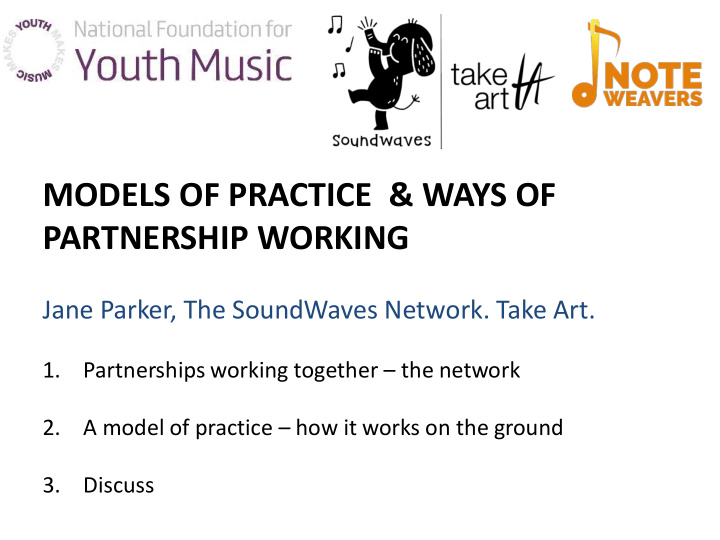



MODELS OF PRACTICE & WAYS OF PARTNERSHIP WORKING Jane Parker, The SoundWaves Network. Take Art. 1. Partnerships working together – the network 2. A model of practice – how it works on the ground 3. Discuss
Take Art is an arts charity based in Somerset • Is an NPO (receives Arts Council Funding) • Involved in arts projects since 1987 working with a range of partners https://takeart.org/what-we-do/areas-of-work One project is The SoundWaves Network https://takeart.org/soundwaves- network • Fund B Youth Music application / Paul Hamlyn / Arts Council /Match funding from our array of partners
The SoundWaves Network across the South West …. vast and rural ….. - Bristol - Yeovil - Plymouth Three learning communities
Partnerships working together across the South West Created three music-learning communities , located in Plymouth , Bristol and Yeovil . Incorporating a strong element of training for the current and future early childhood workforce Take Art - Two EYs Music Practitioners co-facilitating together Two Early Childhood Settings - uni and FE placements HE / FE: (already centres of Early Childhood learning) Studies Degree / level 3 MEH CME: EC students EYs Advisory Team
What are we doing? Each Centre of Learning receives the following each year: Two EYs settings – 10 half day sessions with two EYs music practitioners (Autumn term 5 / Spring term 5 - once a fortnight) Two CPD events – at the start / end – EVERYONE attends (mainly free or £5) FE / HE – receive training event
What does it look like? The model of practice Building on The Little Big Bang Report (Young, 2012), Take Art is mindful that all our EYs music practitioners involved in SoundWaves Network are not viewed as specialists that are parachuted in to lead sessions, but rather as mentors who collaboratively work with practitioners and students in a sustainable fashion , embedding music in to the culture of the Early Years setting. • Three and half hours (half a day) – two EYs music practitioners working together. One setting a.m. LUNCH . One setting p.m. NB Settings are often open 8am to 6pm
Workforce training – the EYs music practitioners
Content of a half a day – all about workforce development • Arrive – touch base / check in • Group session – adult facilitated – designed to provide the other adults with defined music learning activities they can learn and continue. e.g. 4 songs that are very straightforward to learn, appropriate for the age, repeated for adults to become confident with.
Example of a group music session: The role of the Early Years Music Practitioner in an Early Years setting …. https://vimeo.com/321723775
https://vimeo.com/335394337
Music play – modelling being the child’s musical play partner Child led activities that are designed to foster and encourage children’s own music-making. Introduce some kind of provocation or structure e.g. • an area set up with a very few carefully chosen, well-sounding, attractive instruments and an adult ‘ready -to- play’, • a singing tent/den with resident adult ‘ready -to- sing’, • recorded music playing for free dance and movement • a touchscreen musical activity such as bloom ( connected through an interactive whiteboard?) One musician interacting with children while other observes and documents. Swap roles.
What about the role of the Early Years Music Practitioner here? https://vimeo.com/321720739
Finding the spontaneous musical behaviour. Where is the music already happening in the setting unaided by an adult? • Listen to and observe the children very carefully during their free play times. • What vocalising, rhythmic movement and music-like interactions do you notice? • Should you join in? If so, how would you interact? Homework during the week too – upload short films on a share-point …. share at reflection time and the juicy ones at second CPD session.
Collecting musical observations. What musical learning do they show? https://vimeo.com/249500482
Reflection time at the end of each half day session ….
My top tips for successful partnership work ….. 1 . Vet your EYs Music Practitioners. We had a vigorous interview process. 2. Connect your programme to the CREC Certificate of Early Childhood accreditation to support your future music workforce. 3. Take your time to find and work with thriving EYs settings and partners to develop beacons of practice. A struggling setting may have little or no capacity. 4. Explore not only working with the current EYs sector workforce – but the future one. Level 3 / Degree students. Connect with your FE College / Uni. 5. Think about your model or practice. The approach of integrating music as play is much more accessible to EYs practitioners. 6. Music practitioners - work in pairs. This is about their workforce development too. They often work in isolation as freelancers. Plus a much richer musical experience for the setting. 7. Get the students and practitioners to document eg find the spontaneous musiking – film it. It shows they value it. 8. Time to reflect. 9. Make sure EVERYONE (all partners …all practitioners from each setting....their managers etc) attends your CPD …
More information and video footage from the Soundwaves Network: https://takeart.org/soundwaves-network https://takeart.org/early-years/early- years-video-library Presentation by Jane Parker , Soundwaves Extra Practitioner and Project Leader https://takeart.org/profile/jane-parker
Recommend
More recommend